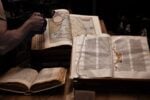Sol LeWitt / Eloise Hawser
.jpg)
Per questa esposizione le opere di entrambi si affiancano e giustappongono in un dialogo che si snoda lungo le stanze della galleria.
Comunicato stampa
La Galleria Vistamare inaugura il 31 ottobre 2015 una mostra di Sol LeWitt ed Eloise Hawser, perseguendo un programma di mostre che vedono affiancate importanti figure di artisti da lungo tempo consacrati a rappresentanti più giovani del panorama internazionale. Per questa esposizione le opere di entrambi si affiancano e giustappongono in un dialogo che si snoda lungo le stanze della galleria. L’accostamento dei singoli lavori rivela, nella assoluta diversità del percorso artistico e dei mezzi utilizzati, un comune interesse nello sviluppo dell’idea di modularità, di motivi che ricorrono costantemente e in maniera sequenziale.
Sol LeWitt (Hartford, Connecticut 1928 – New York 2007)
Figlio di immigrati ebreo-russi in America, Sol LeWitt è stato ed è una delle figure eminenti del movimento Minimalista e Concettuale dalla seconda metà del Novecento in poi. Dopo il periodo universitario, studia arti visive alla Syracuse University, e brevi esperienze come grafico per riviste e progettista presso lo studio dell’architetto I.M. Pei, LeWitt si avvia a sviluppare un corpus di idee che, prendendo le distanze dall’action painting, lo conduce all’ideazione di una serie di strutture basate su un rigido sistema logico di procedura concettuale, che esclude qualsiasi coinvolgimento emotivo dell’artista nella costante ricerca di elementarità e rigore formale. Le sue strutture, termine che preferiva a sculture, sono dei semplici moduli basilari che indagano la forma solida del cubo, un cubo aperto il più delle volte. Le forme geometriche diventano matrici moltiplicate nello spazio. Nel 1968 realizza per Paula Cooper il primo Wall Drawing; uno dei pochissimi realizzati di sua mano, tutti gli altri verranno successivamente eseguiti dai suoi assistenti. Ed è uno dei suoi disegni murali che occupa una delle stanze della galleria, eseguito, così come egli voleva, da assistenti che tutt’oggi viaggiano il mondo realizzando i suoi progetti. Per LeWitt l’arte concettuale stabilisce il primato dell’ideazione sulla creazione, il pensiero diventa più importante della sua espressione nel processo artistico: tutto risiede nell’idea la cui realizzazione può essere eseguita da chiunque in base a rigide e precisissime istruzioni. Il Wall Drawing #460 in mostra svela appieno questi presupposti: sulla piatta superficie muraria si dispiegano coni, piramidi, disegni isometrici, il più delle volte in bianco e nero. Queste forme si arricchiscono di un’ampia gamma cromatica data dalla sovrapposizione degli inchiostri in misteriose e affascinanti miscele. Le pareti sono ignare di ostacoli e cesure. I wall drawing rivelano la forte influenza esercitata dai grandi maestri del ‘300 e ‘400 Italiano: LeWitt guarda con ammirazione agli affreschi di Giotto e Masaccio così come alla prospettiva appiattita e volutamente bidimensionale delle figure di Piero della Francesca. I suoi disegni a parete risolvono il problema del rapporto tra figura tridimensionale e superficie bidimensionale, evocano, aggiornandola, la pittura “a fresco”. Artista prolifico, a partire dagli anni ‘80 realizza delle sculture in blocchi di cemento accatastati l’uno sull’altro, tutti uguali e posti in simmetrica progressione. L’opera intitolata Horizontal Progression #6 del 1995 mostra in modo esemplare come l’utilizzo di strutture modulari abbia sempre origine dalla forma del cubo aperto degli esordi. In mostra anche un gruppo di guache del 2003: le carte sono gli unici lavori che l’artista americano realizza di sua mano. In seguito a una lunga permanenza in Italia, paese che amava e in cui a lungo soggiorna, LeWitt dà vita a una serie di immagini libere da schemi, fluttuanti e sensuali, realizzate in colori contrastanti. Sono lavori creati in serie e basati su un motivo specifico che delinea il costante interesse per la serialità e modularità. I lavori di Sol Lewitt sono presenti nelle più importanti collezioni museali e private del mondo: Tate Modern, Londra, il Van Abbemuseum, Eindhoven, Museo Nazionale Serbo, Belgrado, Centre Georges Pompidou, Parigi, Hallen für Neue Kunst Schaffhausen, Svizzera, Galleria Nazionale Australiana, Canberra, Australia, Guggenheim Museum, the Museum of Modern Art, New York, Dia:Beacon, National Gallery of Art, Washington D.C. e l’Hirshhorn Museum and Sculpture Garden.
Eloise Hawser (Londra 1985)
appartiene alla generazione dei giovani artisti inglesi. Forte di una formazione artistica presso la Ruskin School of Art di Oxford, la Hawser si concentra su un lavoro teso a riconfigurare e proporre materiali dall’apparenza banale, quotidianamente utilizzati nei processi industriali, per realizzare opere e installazioni in grado di svelarne l’intrinseca mutevolezza. In tal modo l’artista esplora il potenziale di oggetti, ora dichiarati obsoleti, destinati nelle sue opere a rivivere attraverso un uso decontestualizzante e contemporaneo. Le tre opere in mostra (Karoshi 2011, Chorley 1 e 2, 2013), le tele in poliestere che riprendono i motivi delle buste postali così come i prototipi di teste poggiati su plinti in resina, elaborano la generosa poetica di quest’artista in grado di offrire, attraverso una rielaborazione del tutto personale, vita e significato nuovo a oggetti ormai dimenticati dal tempo. Strumenti che svolgevano una funzione precisa, spesso meccanica, rinascono, attraverso lo studio scrupoloso e una attenta sensibilità, espressione di un’arte fresca e originale. Eloise Hawser si è laureata alla Ruskin School of Art, Oxford nel 2007 e ha proseguito gli studi alla Stadelschule di Francoforte con Tobias Rehberger (2009-2012). Tra le mostre recenti: nel 2015 Weighted Data (group show), Tate Britain, Londra; Surround Audience, Triennial (group show), New Museum, New York, NY; 2014 Europe, Europe, Astrup Fearnley Museum, Oslo (group show); Don’t You Know Who I Am? Art after Identity Politics (group show), M HKA, Anversa, Belgio. 2013; Burn These Eyes Captain and Throw Them in the Sea (group show), Rodeo, Istanbul, Turchia; Soft Wear curata da Philip Zach, Sandy Brown, Berlino, Germania; Of Love, Pain, and Passioned Revolt (Then Farewell, My Beloved, ’til It’s Freedom Day), ZERO, Milano; One After One, (group show), Vilma Gold, Londra. Mostre personalialla Frieze Art Fair, Frame section, Londra, UK, Liste 18, Basel con VI, VII (Oslo); e Haus der Braut, VI, VII (Oslo).
On 31st October 2015 the Vistamare gallery inaugurates an exhibition of work by Sol LeWitt and Eloise Hawser, as part of the gallery’s programme of exhibitions pairing artists of long-recognised historical importance with young talents currently gaining international recognition. In this show the works of the two artists are flanked and juxtaposed in a dialogue that spreads through the rooms of the gallery. Paired in this way, and despite the artists’ profoundly different experiences and the completely different media employed, the individual pieces reveal a common interest in developing the idea of modularity and sequentially recurring motifs.
Sol LeWitt (Hartford, Conneticut 1928 – New York 2007)
The son of Russian Jewish immigrants to the United States, Sol LeWitt was a leading figure in both Minimal and Conceptual art from the mid twentieth century onwards. Having graduated in Fine Arts from Syracuse University, for a brief period LeWitt worked as a graphic designer for various magazines and in the studio of I.M. Pei, afterwards he began developing a corpus of ideas that, in a reaction against action painting, led him to conceive a series of structures based on a rigidly conceptual logic, excluding any emotional involvement on the part of the artist, in a constant search for purity and formal rigour. His structures (a term he preferred to “sculptures”) are simple basic modules that investigate the form of the cube – frequently an open cube. His geometric forms become matrices multiplying in space. In 1968 he realized his first Wall Drawing for Paula Cooper – one of the only he drew out himself (most successive wall drawings would be physically executed by his assistants). For this show one of the rooms of the gallery will be occupied by a drawing produced, as LeWitt intended, by his assistants, who today continue to travel the world executing his projects. For LeWitt conceptual art establishes the primacy of the idea over its physical realization: the idea itself becomes more important than its expression via the artistic process. All importance resides in the concept, and it can be executed by anyone following strict and precise instructions. The Wall Drawing #460 on show at Galleria Vistamare fully represents these premises: cones, pyramids and isometric drawings unfold on the flat surface of the wall, mostly in black and white, and yet a broad chromatic range enriches the forms thanks to the juxtaposition of the different inks, creating blends that are both fascinating and intriguing. The walls form unbroken surfaces devoid of obstacles. LeWitt’s drawings reveal the powerful influence of the Italian masters of the early renaissance: his admiration of the frescoes of Giotto and Masaccio and of the flattened and deliberately two-dimensional perspective of Piero della Francesca’s figures. His wall drawings resolve the problem of the relationship between the three-dimensional figure and the two-dimensional surface, evoking and bringing up-to-date “a fresco” painting. A prolific artist, from the 1980s onwards he also created sculptures formed of blocks of concrete piled one on top of another, all identical and positioned in a series of symmetrical progressions. Exhibited here, Horizontal Progression #6 (1995) is a perfect example of how LeWitt’s use of modular structures always derives from the open cube of his early works. The exhibition also features a group of gouaches from 2003: the only works on exhibit physically produced by the artist himself. Following a long period in Italy, a country he much loved and in which he lived for many years, LeWitt created a series of images, in strongly contrasting colours, that follow no set rules but are fluctuating and sensual. Works created in series and based on a specific motif, they exemplify his unflagging interest in the serial and the modular. Sol LeWitt’s works can be seen in many of the world’s most important museums and private collections including: Tate Modern, London, the Van Abbemuseum, Eindhoven, the National Museum of Serbia in Belgrade, the Centre Georges Pompidou, Paris, the Hallen für Neue Kunst Schaffhausen, Switzerland, the Australian National Gallery, Canberra, the Guggenheim Museum, the Museum of Modern Art and Dia:Beacon in New York, and the National Gallery of Art and the Hirshhorn Museum and Sculpture Garden in Washington D.C..
Eloise Hawser (London 1985)
is a young British artist and a graduate of the University of Oxford’s Ruskin School of Art. Her work focuses on reconfiguring and repurposing the seemingly banal materials employed in everyday industrial processes, materials of which her art works and installations reveal the intrinsic mutability. In this way she explores the potential of objects that have been declared obsolete and grants them new life, decontextualised and rendered newly contemporary. Whether they take the form of woven polyester canvases imprinted with patterns inspired by postal envelopes or the prototype of a head that is simultaneously a resin plinth, the three works on show at Vistamare (Karoshi, 2011, Chorley 1 and Chorley 2, 2013) all express the generosity that characterizes Hawser’s poetics – her very personal re-elaboration of long-abandoned objects giving them new life and meaning. Through scrupulous research and thanks to the artist’s thoughtful sensitivity, instruments (often mechanical) that once served precise purposes are reborn in an art that is both fresh and original. Eloise Hawser graduated from The Ruskin School of Art, Oxford in 2007 and continued her studies at Stadelschule, Frankfurt under Tobias Rehberger (2009-2012). Recent shows include 2015 Weighted Data (group show), Tate Britain, London; Surround Audience, Triennial (group show), New Museum, New York; 2014 Europe, Europe at the Astrup Fearnley Museum, Oslo (group show); Don’t You Know Who I Am? Art after Identity Politics (group show), M HKA, Antwerp. 2013; Burn These Eyes Captain and Throw Them in the Sea (group show), Rodeo, Istanbul; Soft Wear curated by Philip Zach, Sandy Brown, Berlin; Of Love, Pain, and Passioned Revolt (Then Farewell, My Beloved, ’til It’s Freedom Day), ZERO, Milan; One After One, (group show), Vilma Gold, London. Her solo exhibitions have included presentations at Frieze Art Fair, Frame section, London, Liste 18, Basel with VI, VII (Oslo); and Haus der Braut, VI, VII (Oslo).



